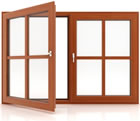How To Fix a Door that Won't Stay Open
Continued from page 1
If you are lucky, the problem may be fixed by simply tightening all the screws in the hinges. Lift the door gently and place magazines under it to support the door. Now tighten all of the hinge screws, on both the door and the door frame. If they were loose, then the problem may be resolved. You might want to replace the screws in the door frame with longer ones to provide better support for the door.
If that didn't work, then the hinges are probably out of plumb. If you want to avoid the trouble of bringing the hinges in to plumb, an option is to tighten the hinge pins in the hinges. By increasing the friction between the hinge plates and the hinge pin, the door will be less likely to swing on its own. The hinge pin is the long pin that connects the knuckles of the two hinge plates together. You may be able to tap the pin firmly into the hinge plates to increase the friction. If the pin has a screw on finial, tightening the finial might have the same affect.
To adjust the hinges to bring them in to plumb, you will need to either adjust the mortise or shim the hinge. Note that these changes will also affect the fit of the door to the door frame. By bringing the door into plumb, it may no longer close properly in an out of plumb door frame.
For a hinge that extends too far into the door opening, you can either deepen the mortise (the little wooden pocket that the hinge plate sits in on the door frame) or shim the other hinge to extend it further into the doorway. Which is better depends upon the fit of the door in the frame. If shimming will cause the door to bind, then deepening the mortise may be the better choice.
Adjusting the hinge will require you to remove the door. Because doors can be quite heavy and are generally unwieldy, always work with an assistant when removing the door. To remove the door, place some magazines under to support its weight. Remove the bottom hinge pin first, then the middle finally the top. The hinge is removed by sliding it up and out of the hinge plate knuckles. If it has a bottom finial, remove the finial first by unscrewing it. If the hinge pin cannot be pulled out, use a nail set at the bottom of the pin and tap it out with a hammer.
With the hinge pins removed, slide the door away from the door frame and set the door aside. Unscrew the hinge plate and insert a shim made from cardboard or chisel out a small amount of wood to deepen or shift the mortise. Replace the door and slip the top hinge pin in first, then the bottom then the middle. Check that the door can close properly then check that it will stand in any position it is placed. Repeat the steps as necessary to fine tune the adjustment.
Page 2 of 2
| Previous page |





